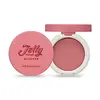What's inside
What's inside
 Key Ingredients
Key Ingredients

 Benefits
Benefits

 Concerns
Concerns

 Ingredients Side-by-side
Ingredients Side-by-side

Cetyl Ethylhexanoate
EmollientButylene Glycol
HumectantCaprylyl Methicone
Skin ConditioningPolybutene
Mica
Cosmetic ColorantSilica
AbrasiveMethyl Methacrylate Crosspolymer
Synthetic Fluorphlogopite
Polyglyceryl-4 Isostearate
EmulsifyingCyclopentasiloxane
EmollientPolypropylsilsesquioxane
Pentylene Glycol
Skin ConditioningCera Microcristallina
Emulsion StabilisingDextrin Palmitate
EmulsifyingStearalkonium Hectorite
Gel FormingCI 77891
Cosmetic ColorantCaprylyl Glycol
EmollientTriethoxycaprylylsilane
CI 77491
Cosmetic ColorantCI 77492
Cosmetic ColorantParfum
MaskingCI 77007
Cosmetic ColorantCI 77499
Cosmetic ColorantCI 73360
Cosmetic ColorantAluminum Hydroxide
EmollientCetyl Ethylhexanoate, Butylene Glycol, Caprylyl Methicone, Polybutene, Mica, Silica, Methyl Methacrylate Crosspolymer, Synthetic Fluorphlogopite, Polyglyceryl-4 Isostearate, Cyclopentasiloxane, Polypropylsilsesquioxane, Pentylene Glycol, Cera Microcristallina, Dextrin Palmitate, Stearalkonium Hectorite, CI 77891, Caprylyl Glycol, Triethoxycaprylylsilane, CI 77491, CI 77492, Parfum, CI 77007, CI 77499, CI 73360, Aluminum Hydroxide
Mica
Cosmetic ColorantCI 77891
Cosmetic ColorantDimethicone
EmollientCaprylic/Capric Triglyceride
MaskingDiisostearyl Malate
EmollientMethyl Methacrylate Crosspolymer
Dimethicone/Vinyl Dimethicone Crosspolymer
Skin ConditioningCyclopentasiloxane
EmollientMicrocrystalline Wax
Emulsion StabilisingCI 77492
Cosmetic ColorantSorbitan Olivate
EmulsifyingCI 15985
Cosmetic ColorantAcrylates/Dimethicone Copolymer
Skin ConditioningCI 45410
Cosmetic ColorantCI 77491
Cosmetic ColorantSorbitan Isostearate
EmulsifyingTriethoxycaprylylsilane
Aluminum Hydroxide
Emollient1,2-Hexanediol
Skin ConditioningSilica
AbrasiveDiethylhexyl Syringylidenemalonate
Skin ProtectingIsoceteth-10
EmulsifyingMica, CI 77891, Dimethicone, Caprylic/Capric Triglyceride, Diisostearyl Malate, Methyl Methacrylate Crosspolymer, Dimethicone/Vinyl Dimethicone Crosspolymer, Cyclopentasiloxane, Microcrystalline Wax, CI 77492, Sorbitan Olivate, CI 15985, Acrylates/Dimethicone Copolymer, CI 45410, CI 77491, Sorbitan Isostearate, Triethoxycaprylylsilane, Aluminum Hydroxide, 1,2-Hexanediol, Silica, Diethylhexyl Syringylidenemalonate, Isoceteth-10
Ingredients Explained
These ingredients are found in both products.
Ingredients higher up in an ingredient list are typically present in a larger amount.
Aluminum Hydroxide is a form of aluminum. It can be naturally found in nature as the mineral gibbsite. In cosmetics, Aluminum Hydroxide is used as a colorant, pH adjuster, and absorbent.
As a colorant, Aluminum Hydroxide may add opacity, or reduce the transparency. Aluminum hydroxide is contains both basic and acidic properties.
According to manufacturers, this ingredient is an emollient and humectant. This means it helps hydrate the skin.
In medicine, this ingredient is used to help relieve heartburn and help heal ulcers.
There is currently no credible scientific evidence linking aluminum hydroxide in cosmetics to increased cancer risk.
Major health organizations allow the use of aluminum hydroxide in personal care products and have not flagged it as a carcinogenic risk at typical usage levels.
Learn more about Aluminum HydroxideCi 77491 is also hydrated iron III oxide. It's sole purpose is to give a red/pink hue to products.
Iron III oxides are classified as inorganic chemicals for coloring.
Synthetically created Ci 77491 is considered safer than those naturally found. This is because the synthetically created version may contain less impurities. Iron oxides are generally non-toxic and non-allergenic.
Learn more about CI 77491Ci 77492 is also hydrated iron III oxide. It's sole purpose is to give a yellow hue to products.
Iron III oxides are classified as inorganic chemicals for coloring.
Synthetically created Ci 77492 is considered safer than those naturally found. This is because the synthetically created version may contain less impurities. Iron oxides are generally non-toxic and non-allergenic.
Learn more about CI 77492Ci 77891 is a white pigment from Titanium dioxide. It is naturally found in minerals such as rutile and ilmenite.
It's main function is to add a white color to cosmetics. It can also be mixed with other colors to create different shades.
Ci 77891 is commonly found in sunscreens due to its ability to block UV rays.
Learn more about CI 77891Cyclopentasiloxane, or D5, is a silicone used to improve texture of products and trap moisture.
D5 is considered lightweight and volatile. Volatile means it evaporates quickly after application. Once evaporated, D5 leaves a thin barrier that helps keep skin hydrated.
It is also an emollient. Emollients help soften the skin and prevent water loss. Silicones create a silky texture in products. D5 helps other ingredients become more spreadable.
Studies show D5 is safe to use in skincare products. We recommend speaking with a skincare professional if you have concerns.
Learn more about CyclopentasiloxaneThis ingredient comes as a powder made up of small, porous, microbeads. It is used to add a silky feel to products and also helps absorb oil.
Mica is a naturally occurring mineral used to add shimmer and color in cosmetics. It can also help improve the texture of a product or give it an opaque, white/silver color.
Serecite is the name for very fine but ragged grains of mica.
This ingredient is often coated with metal oxides like titanium dioxide. Trace amounts of heavy metals may be found in mica, but these metals are not harmful in our personal products.
Mica has been used since prehistoric times throughout the world. Ancient Egyptian, Indian, Greek, Roman, Aztec, and Chinese civilizations have used mica.
Learn more about MicaSilica, also known as silicon dioxide, is a naturally occurring mineral. It is used as a fine, spherical, and porous powder in cosmetics.
Though it has exfoliant properties, the function of silica varies depending on the product.
The unique structure of silica enhances the spreadability and adds smoothness, making it a great texture enhancer.
It is also used as an active carrier, emulsifier, and mattifier due to its ability to absorb excess oil.
In some products, tiny microneedles called spicules are made from silica or hydrolyzed sponge. When you rub them in, they lightly polish away dead skin layers and enhance the penetration of active ingredients.
Learn more about SilicaTriethoxycaprylylsilane is a silicone used to bind and stabilize ingredients.
As an emulsifier, it helps prevent ingredients from separating. This can help elongate the shelf life of products.
Triethoxycaprylylsilane is often used to coat mineral sunscreens ingredients to help give a better feel. It also helps reduce oxidative stress in sunscreens.
Learn more about Triethoxycaprylylsilane